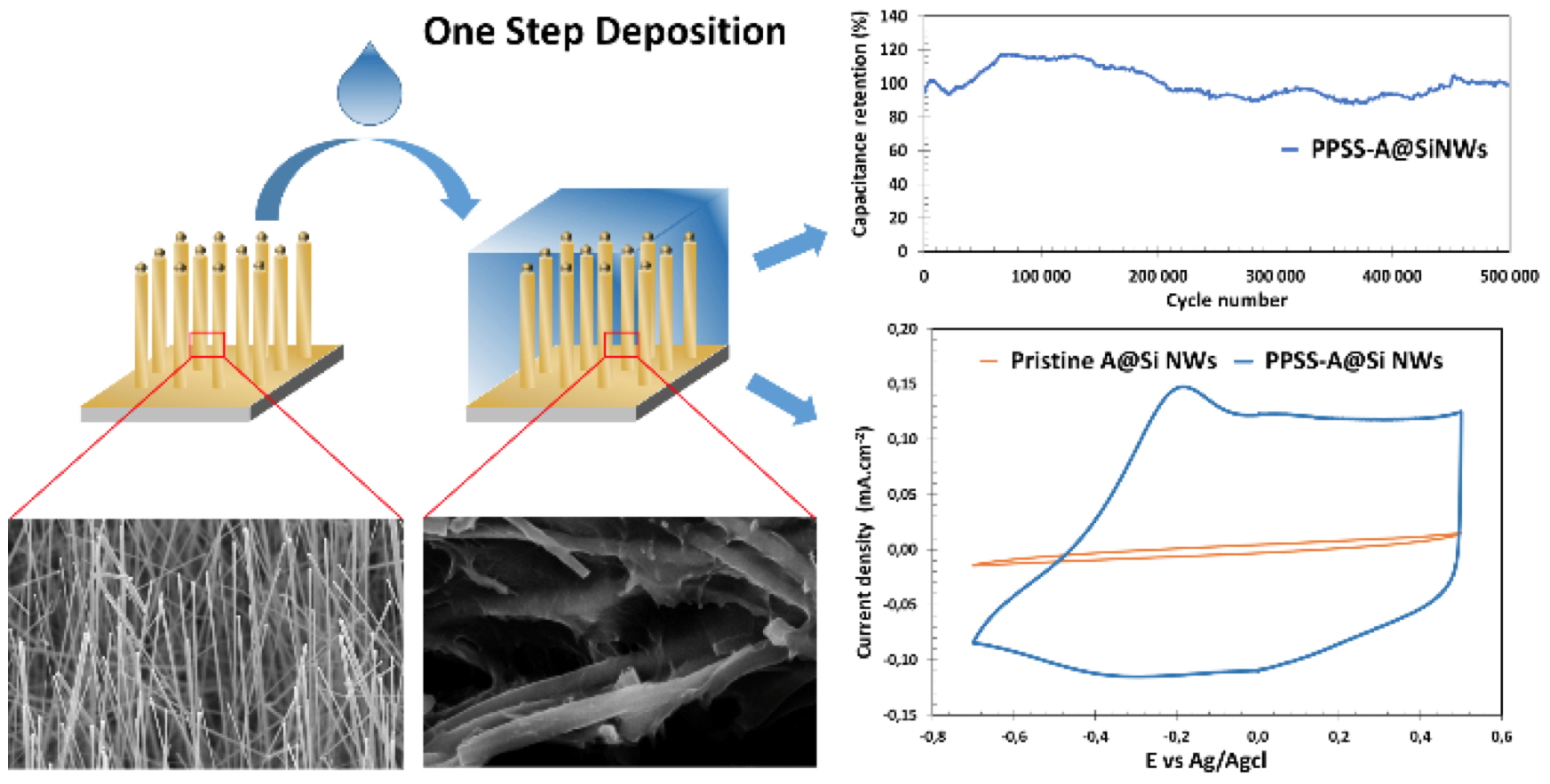The growth of Si, Ge based nanowires and “nanotrees” as demonstrated by SiNaPS during the previous period, has been be further developed. We established, in close collaboration with
SyMMES the applicability of such nanostructures to enhance energy storage capability in super-capacitors and batteries
[1, 2]. We also investigated the wrapping of the wires by graphene sheets and evaluate the potential improvements of the wire mechanical properties and stability upon cycling.
 Si and Ge-based nanostructures for electrochemical energy storage applications
Si and Ge-based nanostructures for electrochemical energy storage applications

Figure: Microsupercapacitor electrode including the initial chemical vapor deposition of the 50μm long silicon nanowires, the atomic layer deposition of the 3 nm alumina layer and the drop-cast of the commercial PEDOT-PSS solution. Capacitance retention of PPSS-A@SiNW symmetric supercapacitor under working conditions as a function of the number of galvanostatic charge/discharge.Three-electrode cell cyclic voltammograms of pristine A@SiNWs (orange curve) and PPSS-A@SiNWs (blue curve) using Na
2SO
4 0.5 M electrolyte.
SiNaPS team in collaboration with the
STEP (SyMMES laboratory) team have focused to increasing the stability and the energy performance of the supercapacitors based on silicon nanostructures electrodes (nanowires and nanotrees). We grow these nanostructures by chemical vapor deposition (CVD) through a vapor-liquid-solid (VLS) process and take here advantage of a substantial increase of the developed surface of the electrode while structured at the nanoscale
[1, 2]. We realized a new nanocomposites electrodes based on silicon nanostructures/ protected nanometric layer/ electronic conducting polymer. This nanocomposite electrode is a real important lever for improving performance in terms of energy density and durability of devices that becomes possible
via ALD layers of Alumina
[2]. We have demonstrated a clear gains of a layer of alumina of less than four nanometers which makes it possible to reach cyclability greater than 8 million cycles and retentions of capacities close to 100%. In addition, the first key steps in the process of producing flexible composite electrodes (Si nanowires / Al
2O
3 / conductive polymers) have recently been successfully completed. Thus a remarkably simple deposition of PEDOT-PSS by drop-casting of an aqueous solution of commercial polymer was used. Despite the poor control over the thickness of the deposit, the gravimetric performances proved to be excellent with a loan capacity retention of 95% over 500.000 cycles for an initial gravimetric capacity 8.5 F. g
-1 and specific energies and powers of 8.2 mJ.cm
-2 and of 4.1 mW.cm
-2. Such cycling stability for a polymer-based nanocomposite in aqueous media combined with first-order electrochemical storage performance is unprecedented in the literature
[3].
 References
[1]
Thissandier F, Dupre L, Gentile P, Brousse T, Bidan G, Buttard D and Sadki S
References
[1]
Thissandier F, Dupre L, Gentile P, Brousse T, Bidan G, Buttard D and Sadki S
Ultra-dense and highly doped SiNWs for micro-supercapacitors electrodes.
Electrochimica Acta, 2014,
117: 159-163
[2]
Gaboriau D, Aradilla D, Brachet M, Le Bideau J, Brousse T, Bidan G, Gentile P and Sadki S
Silicon nanowires and nanotrees: elaboration and optimization of new 3D architectures for high performance on-chip supercapacitors.
RSC Advances, 2016,
6: 81017-81027
[3]
Valero A, Mery A, Gaboriau D, Gentile P and Sadki S.
One step deposition of PEDOT-PSS on ALD protected silicon nanowires: Toward ultrarobust aqueous microsupercapacitors.
ACS Applied Energy Materials, 2019,
2(1): 436-447